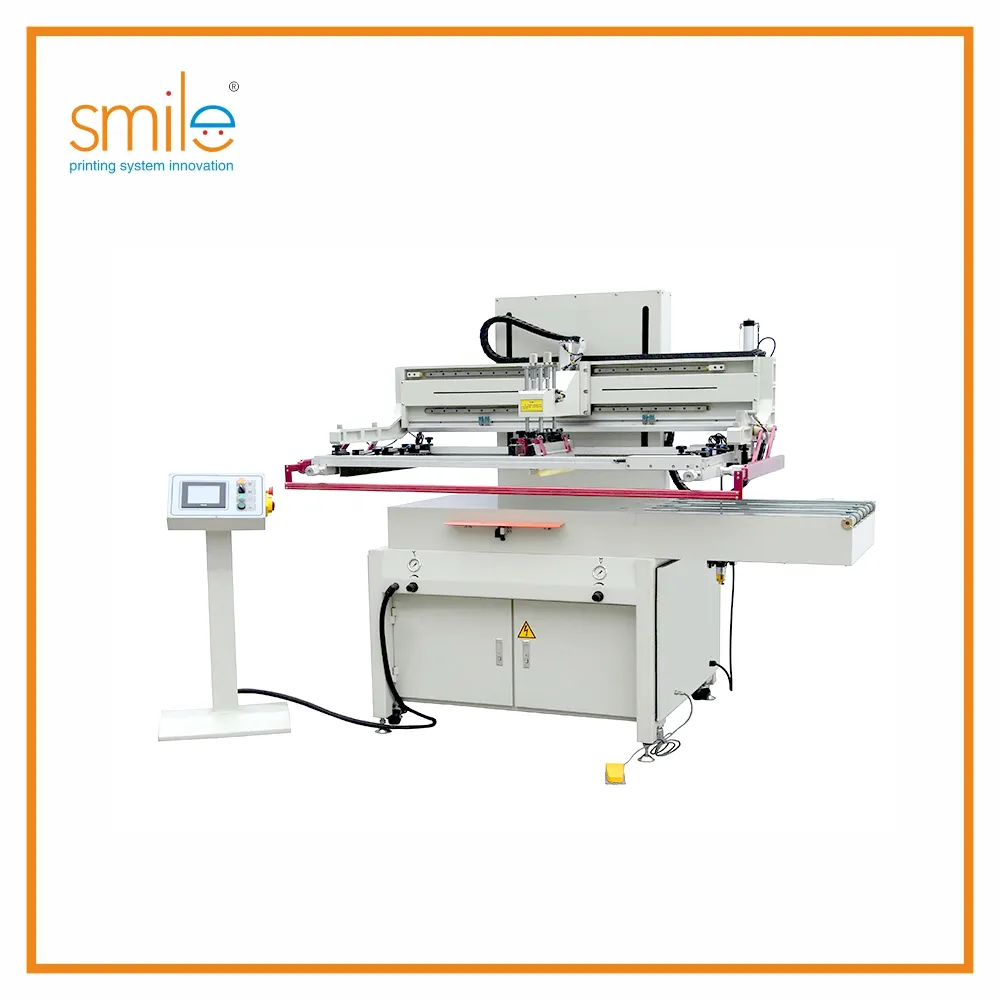การพิมพ์สกรีน เป็นวิธีการที่ใช้กันอย่างแพร่หลายและมีความหลากหลายสำหรับการผลิตลายพิมพ์ที่สดใสและมีเส้นคมชัดบนวัสดุต่าง ๆ การได้เส้นที่สะอาดและสีที่สดใสต้องเข้าใจถึงปฏิสัมพันธ์ระหว่างตะแกรง หมึก และวัสดุพื้นฐาน การปรับปรุงแต่ละขั้นตอนของกระบวนการจะช่วยให้ธุรกิจสามารถรับประกันความสม่ำเสมอและคุณภาพของงานพิมพ์ที่สูงในทั้งการผลิตจำนวนน้อยและจำนวนมาก บทความนี้จะกล่าวถึงแนวปฏิบัติหลักที่ช่วยเพิ่มคุณภาพการพิมพ์ให้ดีขึ้นในขณะที่ยังคงประสิทธิภาพและความเชื่อถือได้
ขั้นตอนสำคัญประการหนึ่งในการให้ได้เส้นที่คมชัดคือการเตรียมตะแกรง ตะแกรงต้องสะอาด มีแรงตึงที่เหมาะสม และเคลือบด้วยสารอีมัลชันที่เหมาะสม การใช้อีมัลชันให้ถูกต้องจะช่วยป้องกันไม่ให้หมึกไหลล้ำและรับประกันว่าลายพิมพ์จะคงรูปร่างตามที่ออกแบบไว้ การตรวจสอบและบำรุงรักษาตะแกรงอย่างสม่ำเสมอถือเป็นสิ่งจำเป็นเพื่อป้องกันข้อบกพร่องที่อาจส่งผลต่อคุณภาพการพิมพ์
ประเภทของหมึกที่ใช้ใน การพิมพ์สกรีน มีผลโดยตรงต่อความคมชัดและความสดใสของสี การเลือกใช้หมึกที่เหมาะสมกับวัสดุพื้นฐาน ไม่ว่าจะเป็นผ้า เนื้อพลาสติก หรือโลหะ จะช่วยให้ยึดติดได้ดีและให้ความเข้มของสีที่เหมาะสม การควบคุมความหนืดของหมึกให้สม่ำเสมอและการผสมหมึกอย่างถูกต้องช่วยลดปัญหาลายเปื้อน คราบ และการกระจายสีที่ไม่สม่ำเสมอ การใส่ใจในรายละเอียดเหล่านี้จะช่วยรักษาความสมบูรณ์ของแบบพิมพ์ที่มีลวดลายซับซ้อน
ยางปาด (Squeegee) เป็นเครื่องมือสำคัญในการพิมพ์สกรีน และการใช้งานอย่างถูกต้องมีความสำคัญต่อการได้เส้นคมชัด การใช้แรงกดให้สม่ำเสมอพร้อมกับรักษาองศาให้คงที่ จะช่วยให้หมึกถ่ายเทได้สม่ำเสมอ ควรตรวจสอบยางปาดอย่างสม่ำเสมอเพื่อหาการสึกหรอหรือความเสียหาย เพราะอาจทำให้เกิดรอยหยักในแบบพิมพ์ นอกจากนี้ การปรับความเร็วในการปาดให้เหมาะสมกับประเภทของหมึกและพื้นผิวของวัสดุ จะช่วยรักษาความแม่นยำของขอบเส้น
สำหรับการออกแบบที่มีหลายสี การจัดแนว (Registration) ที่แม่นยำมีความสำคัญอย่างมาก เพื่อรักษาเส้นแบ่งเขตระหว่างสีให้คมชัด การจัดแนวที่ผิดพลาดอาจทำให้การพิมพ์มีลักษณะเบลอหรือทับซ้อนกัน การใช้เครื่องหมายสำหรับจัดแนว (Registration Marks) หมุดจัดแนว หรือระบบอัตโนมัติ ช่วยเพิ่มความแม่นยำ การลงทุนในระบบจัดแนวคุณภาพสูงจะช่วยรับประกันผลลัพธ์ที่คงที่ แม้ในกรณีที่ผลิตในปริมาณมาก

การทับชั้นของหมึกพิมพ์อย่างระมัดระวัง มีส่วนช่วยให้สีสันมีความสดใส โดยไม่กระทบต่อความชัดเจนของเส้น ปกติแล้วการพิมพ์หลายชั้นที่บางกว่า มักให้ผลลัพธ์ที่ดีกว่าการพิมพ์ชั้นเดียวที่หนาเกินไป ซึ่งช่วยป้องกันการเลอะหรือซึมของหมึก การทดสอบการปกคลุมของหมึกพิมพ์บนวัสดุตัวอย่างก่อนการผลิตจริง ช่วยให้สามารถปรับความหนาและกระบวนการอบให้เหมาะสม รับประกันความเข้มข้นของสีที่สม่ำเสมอ
พื้นผิวของวัสดุที่ใช้พิมพ์มีผลต่อการยึดติดและการปรากฏตัวของหมึก การทำความสะอาด การเตรียมพื้นผิวล่วงหน้า หรือการใช้สารรองพื้นสามารถช่วยเพิ่มความสดใสและความคงทนของสีได้ สำหรับผ้าผืน ควรซักล่วงหน้าและใช้สารบำบัดผ้าที่เหมาะสม เพื่อให้หมึกยึดติดได้อย่างมีประสิทธิภาพโดยไม่ทำให้สีหมองคล้ำ สำหรับพื้นผิวแข็ง ควรทำให้แน่ใจว่าพื้นผิวเรียบ เหนียว และปราศจากฝุ่น เพื่อเพิ่มความคมชัดและความสว่างของสี
ทั้งระบบการพิมพ์แบบโรตารีด้วยเครื่องจักรอัตโนมัติและแบบแมนนวลสามารถให้เส้นคมชัดและสีสันสดใส แต่ระบบอัตโนมัติจะให้ความสม่ำเสมอที่เพิ่มขึ้น ระบบอัตโนมัติช่วยลดข้อผิดพลาดของมนุษย์ในเรื่องแรงกด มุม และการกระจายหมึก รวมทั้งยังช่วยให้ควบคุมตำแหน่งการพิมพ์สีหลายสีได้อย่างแม่นยำ ซึ่งเป็นสิ่งสำคัญต่อคุณภาพงานพิมพ์ระดับสูง
การเลือกตาข่ายสำหรับหน้าจอพิมพ์มีผลต่อการไหลของหมึกและความแม่นยำของเส้น พื้นผ้าตาข่ายที่มีจำนวนเส้นมากจะให้รายละเอียดที่ละเอียดกว่า แต่อาจต้องใช้แรงกดมากขึ้นและใช้หมึกที่บางลง การเลือกตาข่ายที่เหมาะสมจะช่วยให้เส้นคมชัด และสีสันปรากฏชัดเจน การทดลองใช้ตาข่ายประเภทต่าง ๆ สำหรับแต่ละวัสดุและแบบงานพิมพ์ จะช่วยกำหนดสมดุลที่เหมาะสมระหว่างรายละเอียดและความสมบูรณ์ของการเคลือบหมึก
การอบแห้งเป็นขั้นตอนสำคัญเพื่อรักษาความคมชัดของสีและป้องกันไม่ให้หมึกเปื้อนหรือจางหาย การใช้อุณหภูมิและระยะเวลาที่เหมาะสมสำหรับหมึกแต่ละชนิด จะช่วยให้หมึกคงทนและมีอายุการใช้งานยาวนาน เครื่องอบแบบอินฟราเรดหรือเครื่องอบสายพานลำเลียงให้ความร้อนที่สม่ำเสมอ ลดความเสี่ยงของการอบแห้งไม่ทั่วถึงที่อาจทำให้เส้นเบลอ
การใช้สารเคลือบหรือการลงผิวหน้าเพิ่มเติมช่วยเพิ่มความสดใสของสีและป้องกันการสึกกร่อน สารเคลือบสามารถปกป้องงานพิมพ์จากแสง UV การซัก และการขัดถู ซึ่งมีความสำคัญเป็นพิเศษสำหรับผ้าและป้ายโฆษณาภายนอกอาคาร การผสมผสานระหว่างหมึกพิมพ์คุณภาพสูงและการบำบัดหลังพิมพ์ที่เหมาะสม ช่วยให้แน่ใจได้ว่างานพิมพ์จะยังคงคมชัดและสดใสตามกาลเวลา
รอยเปื้อนมักเกิดจากหมึกที่มากเกินไปหรือเทคนิคปาดหมึกที่ไม่ถูกต้อง การปรับแรงดัน ปริมาณหมึก และระยะเวลาในการแห้งจะช่วยป้องกันปัญหานี้ได้ การใช้ขั้นตอนที่สม่ำเสมอในการพิมพ์แต่ละครั้งจะช่วยให้มั่นใจได้ถึงความสามารถในการพิมพ์ซ้ำหลายครั้ง
การจางสีอาจเกิดขึ้นได้หากหมึกไม่เข้ากันได้กับวัสดุพื้นฐานหรือการอบหมึกไม่เพียงพอ การเลือกใช้หมึกที่เหมาะสมและวิธีการอบที่ถูกต้องจะช่วยให้สีสันคงทนยาวนาน การตรวจสอบอย่างสม่ำเสมอในระหว่างกระบวนการผลิตจะช่วยตรวจพบสัญญาณเริ่มต้นของการจางสี และสามารถปรับแก้ก่อนที่จะกระทบต่อจำนวนการผลิตจำนวนมาก
สีที่ไม่ตรงกันอาจทำให้ความชัดเจนของแบบดีไซน์โดยรวมลดลง การรักษาไกด์ตำแหน่งให้ถูกต้อง การตรวจสอบก่อนเริ่มพิมพ์ และการลงทุนในอุปกรณ์ที่มีความแม่นยำ จะช่วยลดข้อผิดพลาดในการจัดแนว การบันทึกค่าต่าง ๆ สำหรับการออกแบบที่ใช้ซ้ำจะช่วยเร่งความเร็วในการตั้งค่าสำหรับงานในอนาคต และรับประกันคุณภาพที่สม่ำเสมอ
การพิมพ์แบบซิลค์สกรีนที่มีเส้นคมชัดและสีสันสดใส ช่วยเพิ่มความน่าสนใจของเสื้อยืด เครื่องแบบ และสินค้าโปรโมชันต่าง ๆ การพิมพ์ที่มีความทนทานช่วยให้ตราสัญลักษณ์ของแบรนด์ยังคงมองเห็นได้แม้ผ่านการใช้งานหรือซักมาหลายครั้ง การพิมพ์ซิลค์สกรีนคุณภาพสูงช่วยให้สามารถพิมพ์ลวดลายที่ซับซ้อนและโลโก้ที่มีสีสันสะดุดตา ซึ่งสามารถดึงดูดความสนใจของผู้บริโภคได้
สำหรับการทำป้ายและฉลากอุตสาหกรรม เส้นคมชัดและสีสันสดใสเป็นสิ่งสำคัญต่อความอ่านง่ายและการนำเสนอที่เป็นมืออาชีพ การพิมพ์แบบซิลค์สกรีนรับประกันคุณภาพที่สม่ำเสมอในทุกล็อต จึงเหมาะสำหรับการผลิตฉลาก โปสเตอร์ และสติกเกอร์จำนวนมากรุ่นใหญ่
การบำรุงรักษาหน้าจอ ไม้ปาดน้ำ และอุปกรณ์การพิมพ์อย่างสม่ำเสมอช่วยให้ได้ผลลัพธ์ที่สม่ำเสมอ การปรับเทียบแรงกด มุม และการไหลของหมึกช่วยป้องกันข้อบกพร่องและรักษาความคมชัด กำหนดการซ่อมบำรุงเชิงป้องกันช่วยลดเวลาหยุดทำงานและช่วยปกป้องการลงทุนในอุปกรณ์การพิมพ์สกรีน
ผู้ปฏิบัติงานที่ได้รับการฝึกอบรมอย่างดีมีผลโดยตรงต่อคุณภาพการพิมพ์ ขั้นตอนการปฏิบัติมาตรฐาน (SOPs) ให้คำแนะนำที่สม่ำเสมอเกี่ยวกับการเตรียมหน้าจอ การจัดการหมึกพิมพ์และการปรับแนว การฝึกอบรมอย่างต่อเนื่องช่วยให้พนักงานปรับตัวให้เข้ากับหมึกใหม่ พื้นผิววัสดุใหม่ หรือความซับซ้อนของแบบพิมพ์ ทำให้รักษาระดับคุณภาพการผลิตที่สูงตลอดเวลา
การควบคุมคุณภาพในช่วงการผลิตช่วยให้ตรวจพบปัญหาได้แต่เนิ่นๆ เช่น รอยเปื้อน หมึกจาง หรือการพิมพ์ล้ำหน้า การสุ่มตัวอย่างงานพิมพ์และตรวจสอบความสม่ำเสมอของสี ช่วยให้แน่ใจว่าแต่ละล็อตเป็นไปตามมาตรฐาน การใช้รายการตรวจสอบคุณภาพช่วยให้การยืนยันเป็นระบบและลดของเสีย
หมึกพิเศษ เช่น หมึกเมทัลลิก หมึกเรืองแสง หรือหมึกพัฟ ช่วยเพิ่มมิติและความสดใสให้กับงานพิมพ์ หมึกเหล่านี้ต้องการการควบคุมและการอบแห้งอย่างแม่นยำเพื่อรักษาเส้นสายที่คมชัด การทดลองใช้หมึกพิเศษกับงานพิมพ์ตัวอย่างจะช่วยให้กำหนดค่าผสมที่เหมาะสมที่สุดสำหรับแต่ละแบบได้
แบบที่ซับซ้อนมักจะต้องใช้เทคนิคการซ้อนชั้นหรือเอฟเฟกต์โทนพ้อยท์ เมื่อทำได้อย่างเหมาะสม เทคนิคเหล่านี้จะช่วยเพิ่มความน่าสนใจทางสายตาโดยยังคงความชัดเจนไว้ ปรับจำนวนตาข่าย ความหนาของหมึก และการอบแห้งระหว่างชั้นต่างๆ เพื่อป้องกันหมึกไหลล้นและรักษาความละเอียดของเส้น
เทคนิคการปาดหมึกที่เหมาะสม การควบคุมปริมาณหมึก และระยะเวลาการแห้งที่สม่ำเสมอ ช่วยป้องกันไม่ให้หมึกเลอะเลือน
การจัดแนวที่แม่นยำ เครื่องมือจัดระดับที่แม่นยำ และการทดสอบก่อนเริ่มพิมพ์จริง ช่วยให้สีแต่ละสีแยกจากกันอย่างชัดเจน
ใช่ หมึกพิเศษจำเป็นต้องได้รับการจัดการและอบแห้งอย่างระมัดระวัง แต่ก็สามารถให้สีสันสดใสและคงทนเมื่อใช้งานอย่างเหมาะสม
ควรทำการบำรุงรักษาเป็นประจำก่อนเริ่มต้นใช้งานในแต่ละครั้ง พร้อมทั้งทำความสะอาดและปรับเทียบเครื่องมืออย่างละเอียดเป็นระยะเพื่อรักษาคุณภาพ